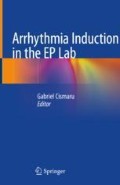Abstract
One of the main challenges in evaluating a patient with palpitations is determining the type of arrhythmia that is responsible for the patient’s symptoms. Many of the available outpatient monitors have limitations in the number of channels they can record or the amount of data they can store for analysis. In many instances, the initiation and termination of the arrhythmia are not captured on these monitors, and essential information for a correct diagnosis is not available. Ideally, the arrhythmia should be recorded on a 12-lead electrocardiogram for a correct diagnosis, but most of the time, this is possible only when the arrhythmia is sustained long enough to be still present when the patient arrives at the hospital. In the best case scenario, the arrhythmia is recorded on a heart monitor or 12-lead ekg, and then a pre-ablation strategy can be developed. Depending on the protocol used to induce arrhythmia, the clinical arrhythmia might be inducible along with other arrhythmias which might not be clinical. Knowing the type of arrhythmia the patient has as outpatient helps guide the ablation of the inducible arrhythmia that has similar characteristics, rather than map and ablate all inducible arrhythmias in the EP lab.
Access this chapter
Tax calculation will be finalised at checkout
Purchases are for personal use only
Abbreviations
- AP:
-
Accessory pathway
- AT:
-
Atrial tachycardia
- AVNRT:
-
Atrioventricular reentry (or reciprocating) tachycardia
- AVRT:
-
Atrioventricular reentrant (or reciprocating) tachycardia
- EKG:
-
Electrocardiogram
- EP:
-
Electrophysiology
- ORT:
-
Orthodromic reciprocating tachycardia
- PVC:
-
Premature ventricular contractions
- Short RP tachycardia:
-
Short R wave to P wave tachycardia
- SVT:
-
Supraventricular tachycardia
- VT:
-
Ventricular tachycardia
References
Smith WM, Broughton A, Reiter MJ, Benson DW Jr, Grant AO, Gallagher JJ. Bystander accessory pathway during AV node re-entrant tachycardia. Pacing Clin Electrophysiol. 1983;6(3 Pt 1):537–47.
Niksch A, Liberman L, Clapcich A, Schwartzenberger JC, Silver ES, Pass RH. Effects of remifentanil anesthesia on cardiac electrophysiologic properties in children undergoing catheter ablation of supraventricular tachycardia. Pediatr Cardiol. 2010;31(7):1079–82.
Pires LA, Huang SK, Wagshal AG, Kulkami RS. Electrophysiological effects of propofol on the normal cardiac conduction system. Cardiology. 1996;87(4):319–24.
Hermann R, Vetterman J. Change of ectopic supraventricular tachycardia to sinus rhythm during administration of propofol. Anesth Analg. 1992;75(6):1030–2.
Tsiachris D, Koutagar J, Gatzoulis KA, Arsenos P, Rigatou A, Dilaveris P, et al. Diagnosis and management of phantom tachycardias based on an electrophysiologically guided approach. Hell J Cardiol. 2016;57(5):340–4.
Jackman WM, Wang XZ, Friday KJ, Roman CA, Moulton KP, Beckman KJ, et al. Catheter ablation of accessory atrio-ventricular pathways (Wolff-Parkinson-White) by radiofrequency current. NEJM. 1991;324(23):1605–11.
Hanninen M, Yeung-Lai-Wah N, Massel D, Gula LJ, Skanes AC, Yee R, et al. Cryoablation versus RF ablation for AVNRT: a meta-analysis and systematic review. J Cardiovasc Electrophysiol. 2013;24(12):1354–60.
Liao JN, Hu YF, Wu TJ, Fong AN, Lin WS, Lin WJ, et al. Permanent pacemaker implantation for late atrioventricular block in patients receiving catheter ablation for atrioventricular nodal reentrant tachycardia. Am J Cardiol. 2013;111(4):569–73.
Schwagten B, Knops P, Janse P, Kimam J, Van Belle Y, Szill-Torok T, et al. Long-term follow-up after catheter ablation for atrioventricular nodal reentrant tachycardia: a comparison of cryothermal and radiofrequency energy in a large series of patients. J Interv Card Electrophysiol. 2011;30(1):55–61.
Shurrab M, Szill-Torok T, Akca F, Tlong I, Kagal D, Newman D, et al. Empiric slow pathway ablation in non-inducible supraventricular tachycardia. Int J Cardiol. 2015;179:417–20.
Azegami K, Wilber DJ, Arruda M, Lin AC, Denman RA. Spatial resolution of pacemapping and activation mapping in patients with idiopathic right ventricular outflow tachycardia. J Cardiovasc Electrophysiol. 2005;16(8):823–9.
Dixit S, Gerstenfeld EP, Callans DJ, Marchlinski FE. Electrocardiographic patterns of superior right ventricular outflow tract tachycardias: distinguishing septal and free-wall sites of origin. J Cardiovasc Electrophysiol. 2003;14(1):1–7.
Stevenson WG, Friedman PL, Sager PT, Saxon LA, Kokovic D, Harada T, et al. Exploring postinfarction reentrant ventricular tachycardia with entrainment mapping. JACC. 1997;29(6):1180–9.
Author information
Authors and Affiliations
Corresponding author
Editor information
Editors and Affiliations
Rights and permissions
Copyright information
© 2019 Springer Nature Switzerland AG
About this chapter
Cite this chapter
Lazar, S. (2019). Introduction: Why Do We Need Arrhythmia Induction?. In: Cismaru, G. (eds) Arrhythmia Induction in the EP Lab. Springer, Cham. https://doi.org/10.1007/978-3-319-92729-9_1
Download citation
DOI: https://doi.org/10.1007/978-3-319-92729-9_1
Published:
Publisher Name: Springer, Cham
Print ISBN: 978-3-319-92728-2
Online ISBN: 978-3-319-92729-9
eBook Packages: MedicineMedicine (R0)

